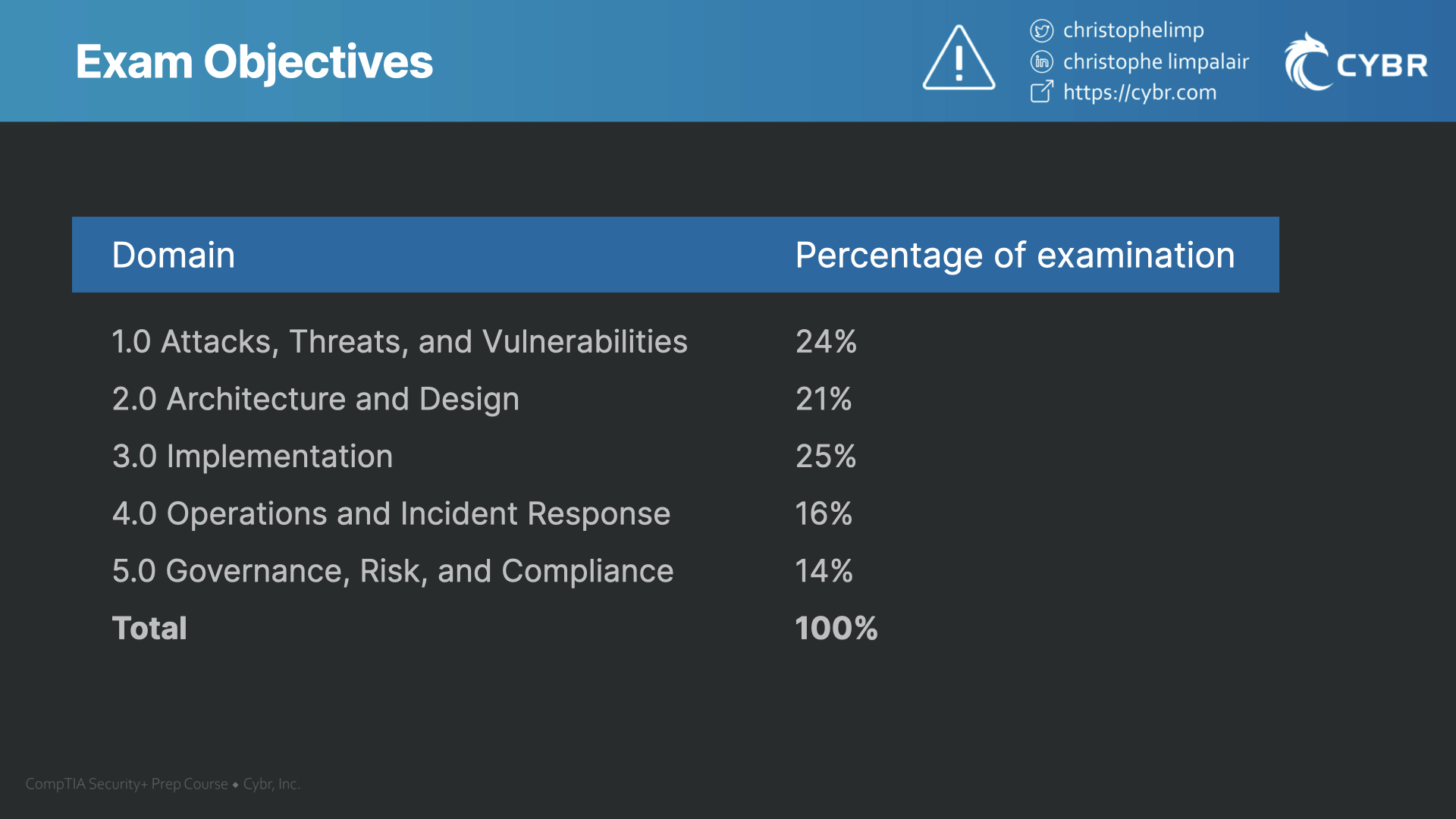Hello and welcome to Cybr’s CompTIA Security+ SY0-601 certification course. I know you’re excited to get started but please give me a few minutes first because there is some important information in this lesson.
The Security+ exam is considered by many to be one of the easier certifications to start with if you’re interested in cybersecurity. That’s not to say that the exam is super easy, especially if you don’t have much background in IT or if you have a hard time taking exams. However, my goal with this course is to make the exam seem like a walk in the park.
Domains
It does cover a wide range of topics, and that’s where most of the studying complexity comes from. In fact, there are 5 different domains:
- 1.0 Attacks, Threats, and Vulnerabilities – which is 24% of the exam
- 2.0 Architecture and Design – which is 21% of the exam
- 3.0 Implementation – which is 25% of the exam
- 4.0 Operations and Incident Response – which is 16% of the exam
- 5.0 Governance, Risk, and Compliance – which is 14% of the exam

I’ve structured the syllabus to closely match CompTIA’s official exam guide and domains. Sometimes it might be a little bit out of order simply because I thought the new order would provide a better learning experience. But, if it’s in the CompTIA official guide, you can rest assured that it will be in my course.
I personally passed the SY0-601 exam recently, so I’ve been through what you’re about to go through both in terms of studying and in terms of taking the exam, and that also means I know what you can expect to see on the exam.
I’ve used that experience to craft this course, and to craft practice exams.
Practice Exams
Speaking of practice exams, by enrolling in the course on the Cybr website, you automatically receive access to our exams as well. They are not in the same syllabus, although there will be a link to them at the end of this syllabus in order to take you directly there once you’re ready. Otherwise, you can find the practice exams on our Courses page.
They’re in a separate “course” because that way you actually get 2 separate Certificates of Completion — one for completing the course, and one for completing all of the practice exams.
You can expect at least 3 sets of Performance-based Questions which mimic the types of performance-based questions you will get on the real exam, and you can also expect 3 sets of multiple-choice questions that range from 80 to 90 questions.
Those are the two main types of questions that you will see on the exam. Performance-based questions can include things like:
- Ordering
- Fill in the blank – such as configuring networking security on devices, for example
- Matching
The reason for the range in the number of questions is because not everyone will get the same number on their exam. I only got 82 questions, including 3 performance-based ones, which means I only got 79 multiple-choice questions. Others that I’ve talked to have gotten 85, and so on…
So this range provides a more realistic experience.
Passing score
In order to pass the real exam, you need to get at least a 750 on a scale of 100 – 900. For that reason, I recommend that you consistently get at least an 80% pass rate on my practice exams before you consider taking the real exam.
Experience needed?
CompTIA recommends that you have at least 2 years of work experience, and while I’ve known people with zero experience who have passed the exam after a few months of studying, I do expect that you have some IT knowledge, but I will also try not to make too many assumptions, and I will cover what you need to know in order to pass.
If you are a beginner and there are some concepts that you’re struggling with, don’t rush! This is not a race. Take your time and re-visit the lessons as many times as you need. Also, join our Discord community where I can help answer questions and where you can meet other students going through a similar journey.
Conclusion
There are a lot of exciting topics in this course, and then there are some drier or more boring topics. Either way, I’m going to do my best to keep it interesting and entertaining because I want you to be prepared and I want you to pass your CompTIA Security+ exam.
If you have any questions, don’t hesitate to ask — you can ask questions directly at the bottom of this page, or again, on our Discord community.
With that, let’s get started!


What is the discord server address
Hi Justin, the Discord can be accessed from https://cybr.com/discord